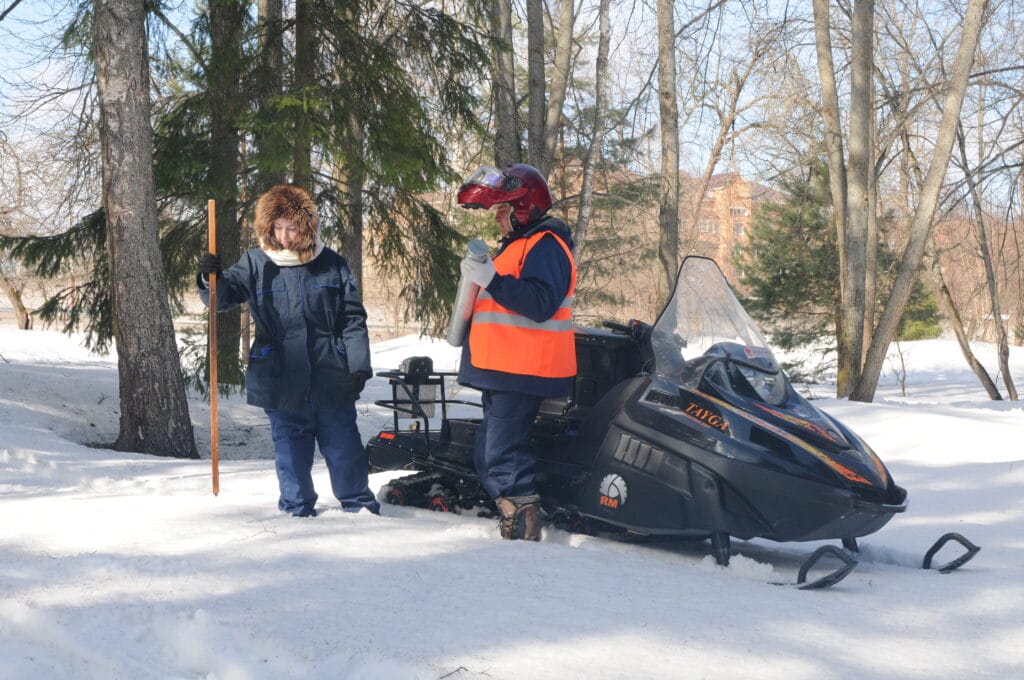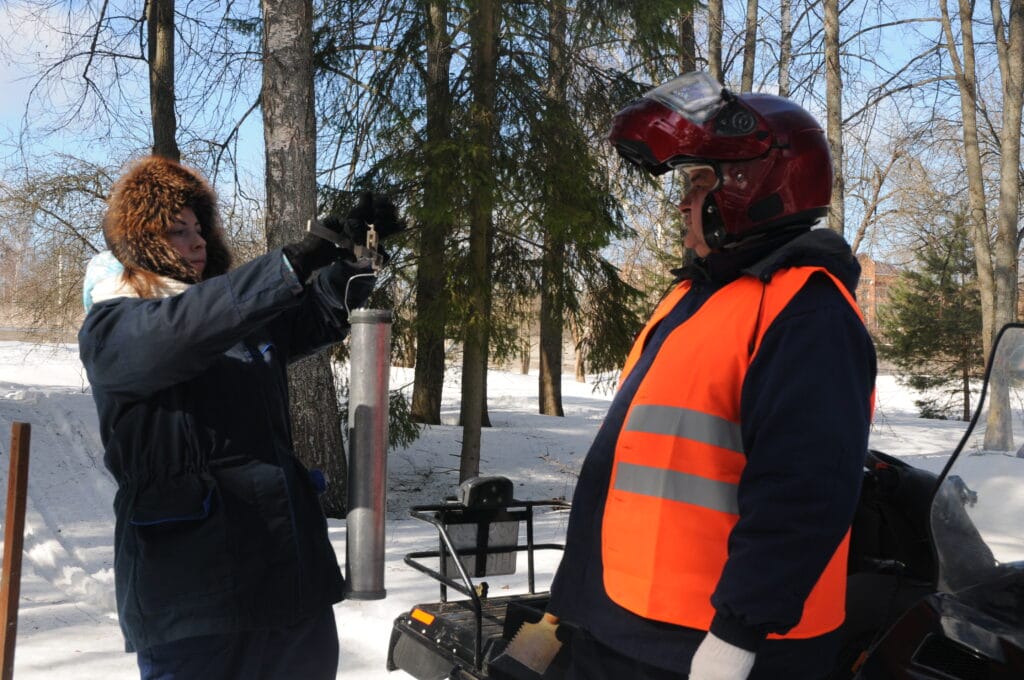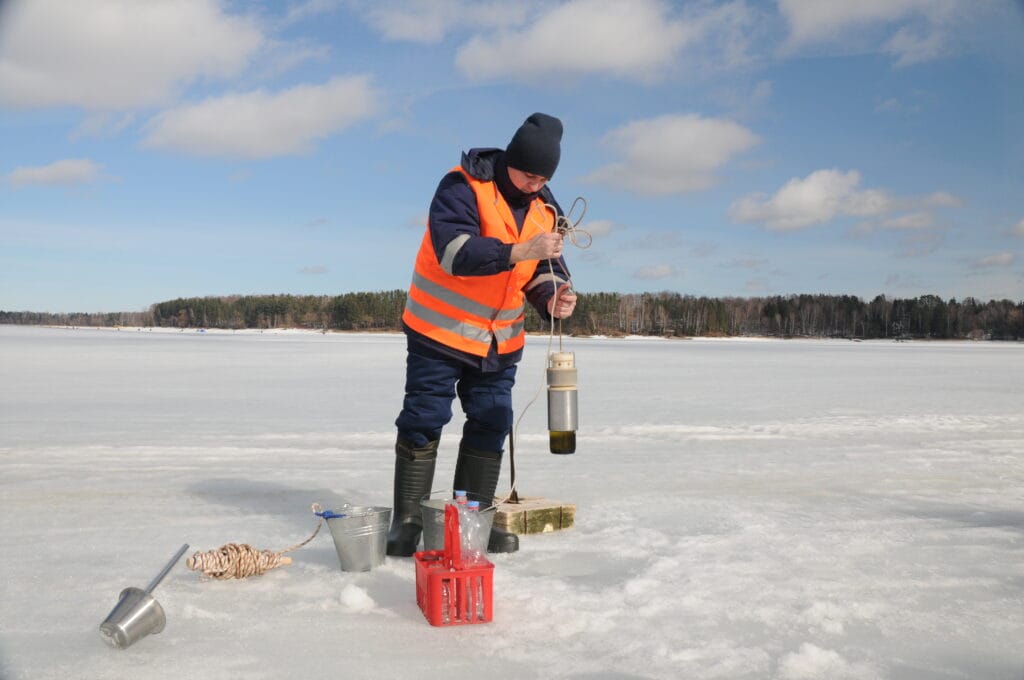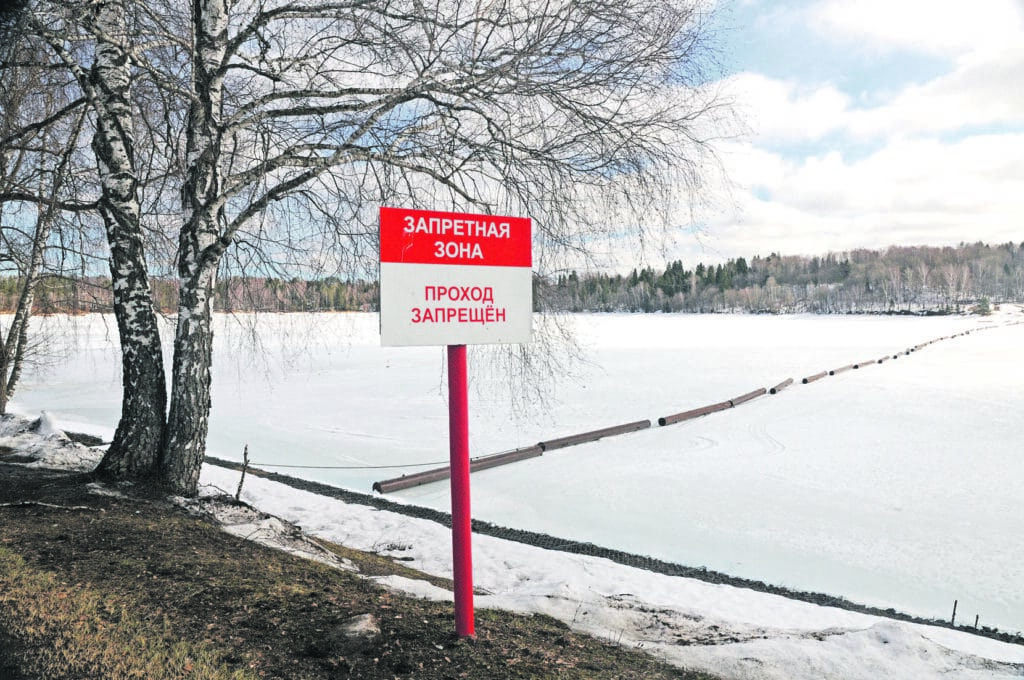Istra reservoir is ready for the flood
[ad_1]
Spring is coming, the snow is melting. Water collects in streams, streams in streams, and they flow into rivers. Including the Istra River in the northwest of the Moscow Region. The river flows on and on until it hits the dam. And it turns out the Istra reservoir – a huge supply of drinking water for Moscow.

“We are starting to prepare ahead of time for water intake,” says Yury Gusev, head of the Istra hydrotechnical unit. – After the first snowfalls, we begin to make snow surveys and determine the amount of water that will come from the catchment area in the spring. Before the onset of spring floods, we prepare the free capacity of the reservoir, gradually discharging water through hydraulic structures, freeing up space in the reservoir to receive new water.
How many millimeters per kilogram of snow?
The catchment area is rather big: 1010 sq. km. The snowmobile “Taiga” rushes through the melted snow. There are two people on the Taiga: Nikolai Zhuravlev, an operator of locking facilities, and Anastasia Noskova, an engineer-hydrologist. The girl is armed with a long rail for measuring the height of snow and special scales. “Taiga” stops, a hydrologist sticks a rail into the snow, marks its height. Then he picks up a column of snow on the scales and weighs it – in this way its density is calculated.
“We have an annual permanent route where we measure the height of the snow cover and its density at the same points,” says Anastasia. – Frequency – once every ten days in winter and once every five days with the onset of snowmelt. In the field, control points are located every 150 meters, in the forest – every 100 meters.
Here’s a physics problem for you. Given: the density of the snow and its height. This is converted into millimeters – how thick a layer of water forms when a certain amount of snow of a given density melts. And then all these millimeters from the entire water intake area are converted into cubic meters and they understand how much water should enter the reservoir. Of course, taking into account the fact that something will be lost along the way – for example, it will be absorbed into the ground.

This year, Anastasia believes, the reservoir will be almost completely filled with water. Yuri Gusev named a specific figure – about 100 million cubic meters.
– This is the usual average annual value, – comments the head of the Istra hydrotechnical unit. We accepted the same amount last year.

With the onset of warm weather, the snow melts quickly. Another three or four days, Anastasia and Nikolai believe, they will travel along the route in the Taiga. And then you have to walk. There will still be snow, it is necessary to measure it, but the Taiga will not pass. A day or two more hydrological engineers will help out the skis, but they will soon become useless. But measurements still need to be done!
Clean water is the key to health!
Equally important is water quality control. To do this, Sergey Priseko, a specialist in monitoring the sanitary protection zones of the Rublevskaya water treatment plant, goes out on the ice. He goes to a hole specially carved in the ice, next to which the Mosvodokanal flag is set.
Taking a water sample is not an easy task. First, water is taken with an ordinary long-handled ladle and poured into plastic bottles. Water must be poured from the top so that air does not get in – this can distort the results of the research.

But, in addition to surface water, it is necessary to take another sample from the very bottom. For this, a special device is used – a bathometer. The bathometer on a cable is lowered into the hole to the very bottom, then a sinker is dropped there – it hits the bottle and locks it. Thus, bottom water does not mix with surface water.
At different times of the year, water samples are taken in different ways.
“In the summer, from the end of April to November,” says Sergey Priseko, “water is taken at three points: near the village of Pyatnitsa, near the village of Berezhki and in the Lower Katysh Bay. Plus, the fourth point is the near-dam zone of the hydroelectric complex.
In winter, water is taken from a hole in the dam zone. The schedule is the same as with measuring the thickness and density of the snow cover – once every ten days. But with the onset of positive temperatures and the beginning of snowmelt, water samples are taken every day. Because in high water, the properties of water can change daily. Water from roads and fields flows into the river. Water flows from farms, car depots, from construction sites, from residential villages – but you never know where!
The Istra reservoir freezes well, the ice is still strong. But, of course, there comes a period when it is already dangerous to go out on the ice, but there is still no open water. At this time, samples are taken only from hydraulic structures.

– I think that this year such a time will come in early April, – says Sergey Priseko.
The collected water is sent to the laboratory and examined for contamination. They, of course, happen, but not critical.
“Most often these are leaks from agricultural facilities or from sewerage systems,” says Yury Gusev. – They give a change in the quality of natural water in terms of organoleptic properties (odor indicators), as well as bacteriological indicators. But during floods, enough water flows along the river to dilute these small nuances.
Any, even the most insignificant, change in the properties of water is immediately recorded by the laboratory. Well, then the water is thoroughly cleaned.
The first stage is coagulation and settling. A coagulant is added to the water – usually aluminum sulfate. This compound reacts with suspended particles, collects them into large flakes.
This process is enhanced by the flocculant – activated carbon. By the way, in high water it is especially necessary, because it is at this time that the water is very turbid and there are a lot of suspended particles in it.
Then the water is passed through the plates – lamellae, which trap the formed flakes.
The water is already clear, but not yet clean. It is passed through filters that use quartz sand and anthracite. Then disinfected with sodium hypochlorite. After the water treatment station, water must still travel a long way through the water supply networks. Hypochlorite just provides a long-term disinfecting effect.
In addition, ozonation is also present in the cleaning scheme – it kills bacteria. Unfortunately, the effect of ozone does not last long, and it is impossible to confine oneself to such disinfection.
Like a small river watering a big city
By the standards of Russia, the Istra River cannot be called large. It originates on the Moscow Upland near the village of Konkovo in the Moscow region. Its length is 113 km, the basin area is 2050 sq. km. Compared with other tributaries of the Moskva River, the Istra ranks first in terms of basin area and second in length, after Pakhra. The annual water consumption is 12.1 m3/s (cubic meters per second). The river is shallow, in the lower reaches from 1 to 1.5 m. And slow: 0.1 – 0.3 m / s.
Regarding the name, there are two versions. The first is Baltic: Baltic tribes lived in the western suburbs before the arrival of the Slavs. For example, in the Lithuanian and Latvian languages there is the word strauja – flow, flow.

The second version is Slavic. Jet, rod, rapids, as well as the names of the rivers Struma, Styr, Strii.
Which version do you prefer? As a rule, the larger the object, the more ancient its name. Istra quite “pulls” on the river with an ancient, pre-Slavic origin of the name.
However, whatever the origin, it still has the same source – the ancient Indo-European base -str- (“flow”), from which both the Baltic strauja and the Russian stream originated.
The first mention of the Istra River is contained in the spiritual charter of the Grand Duke Vasily Vasilyevich the Dark (1461). For some time, the river was divided into two – Bolshaya Istritsa and Bolshaya Istra. It is known that after 1552, by decree of Tsar Ivan Vasilyevich the Terrible, the “Book of the Great Drawing” was compiled – a drawing “for the entire Muscovite state”. The third edition of the drawing, drawn up in 1627, is reliably known, and in it the Istra is again one river.
According to its regime, the Istra is a typical Eastern European river: it receives most of its water from snow. Melt water accounts for 60 percent of all water. It receives another 28 percent from underground sources and 12 percent from rain. This is clearly seen in the flow of water. As already mentioned, the average annual consumption is 12 cubic meters per second, but in April it rises to 49 cubic meters, and in the winter months it drops to 6.5.
It is because of this regime that reservoirs are being built in the west of Russia – in order to retain as much spring water as possible.

A dam for the reservoir was built in 1935 near the village of Rakovo. Now this is a settlement of the Kuibyshev hydroelectric complex, and 902 people live here. The river overflowed, forming a reservoir with a volume of 183 million cubic meters. m and an area of 33.6 sq. km. The length of the reservoir is 25 km, the average width is 1.5 km, but the depth in some places can reach 20 m. During the flood, the water can rise by 2.5 – 3.5 meters.
Initially, it was supposed to build a canal here and connect the Volga with the Moscow River along the line Gorodishche – Klin – Istra. However, the Moscow Canal was eventually built elsewhere, and a water intake and energy hub appeared here. In addition to water intake facilities and a spillway, there is also a dam-type hydroelectric power plant, which produces an average of 7 million kWh per year.
There are quite a lot of fish in the river. Up to the dam, in the reservoir itself, there are pike perch, bream, burbot, silver bream, ide, roach, perch, pike, bleak, tench, ruff. Below the Istra hydroelectric complex, you can catch chub, minnow, char, ide, and asp.
Once the Istra reservoir was even used for navigation. Now it is a protected area for fishing, water supply and recreation.
Yana MAYEVSKAYA.
Author’s photo
[ad_2]
Source link








